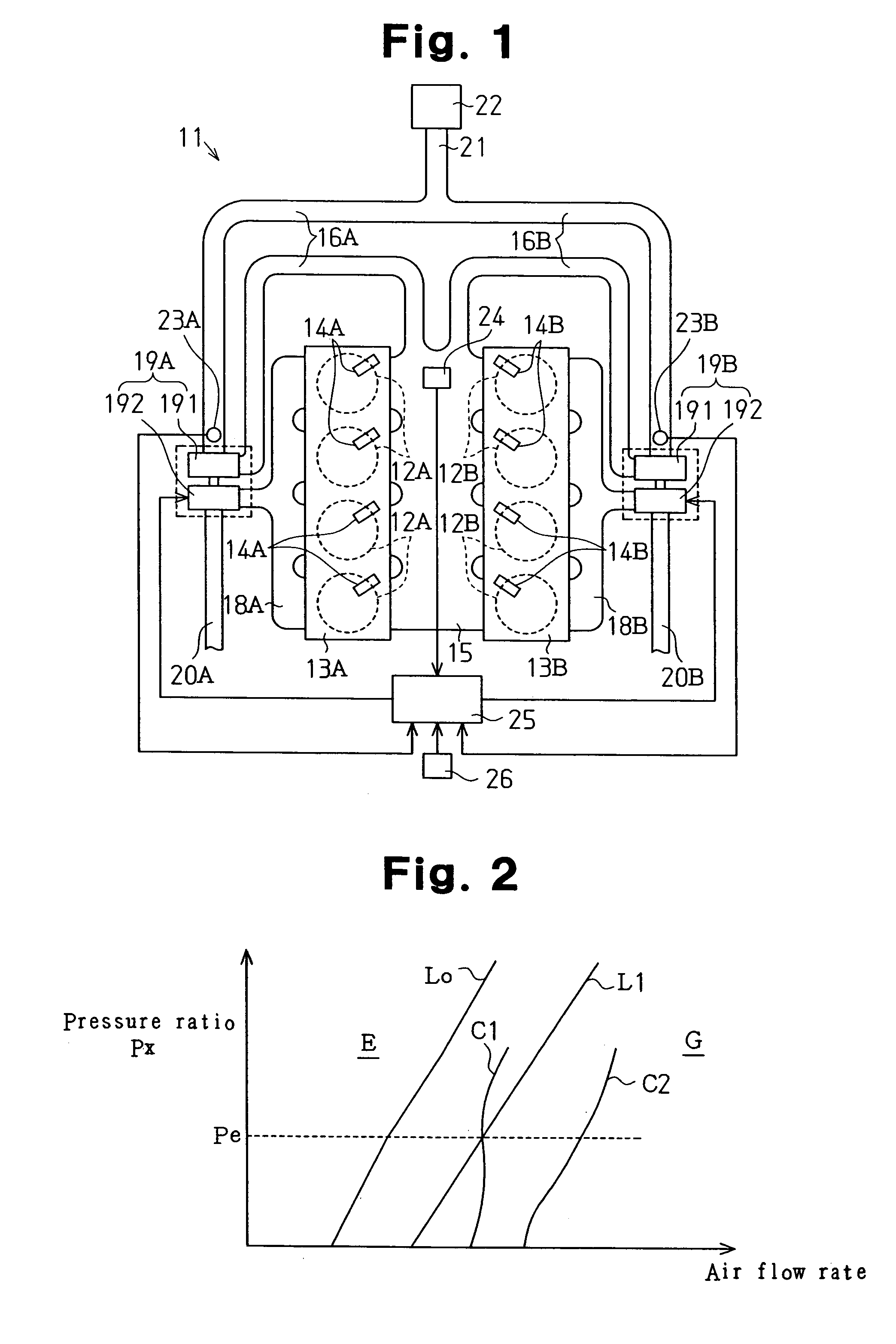Supercharge control apparatus and supercharge control method for supercharged internal combustion engine
a control apparatus and internal combustion engine technology, applied in the direction of engine controllers, combustion engines, machines/engines, etc., can solve the problems of supercharger having a low supercharging capability, intake air flowing backward, surge,
- Summary
- Abstract
- Description
- Claims
- Application Information
AI Technical Summary
Benefits of technology
Problems solved by technology
Method used
Image
Examples
first embodiment
[0020]the present invention will now be described with reference to FIGS. 1–3.
[0021]As shown in FIG. 1, an internal combustion engine 11 includes a first group of cylinders 12A and a second group of cylinders 12B. Fuel injection valves 14A are attached to a cylinder head 13A corresponding to the first group of cylinders 12A. Each fuel injection valve 14A corresponds to one of the cylinders 12A. Fuel injection valves 14B are attached to a cylinder head 13B corresponding to the second group of cylinders 12B. Each fuel injection valve 14B corresponds to one of the cylinders 12B. The fuel injection valves 14A, 14B inject fuel into the cylinders 12A, 12B.
[0022]The cylinder heads 13A, 13B are connected to an intake manifold 15. The intake manifold 15 is connected to branch intake passages 16A, 16B. A compressor unit 191 of a first supercharger 19A is located in the branch intake passage 16A and a compressor unit 191 of a second supercharger 19B is located in the branch intake passage 16B....
second embodiment
[0047]A control computer 25C controls the opening degree of the vane in the turbine 192 of each supercharger 19A, 19B in accordance with the surge prevention control program shown in the flowchart of FIG. 4(b).
[0048]The surge prevention control program of the second embodiment differs from the first embodiment in that steps S6, S8 of the surge prevention control program according to the first embodiment are replaced with steps S9, S10. The steps S9, S10 will be described below.
[0049]If the decision outcome of step S4 is NO, that is, if it is determined that the boost condition (Px, F1) is within the surging area E and the boost condition (Px, F2) is not within the surging area E, the control computer 25C proceeds to step S9 and decreases the opening degree of the vane in the first supercharger 19A. Decreasing the opening degree of the vane in the first supercharger 19A increases the air flow rate of the first supercharger 19A. Increasing the air flow rate of the first supercharger ...
third embodiment
[0056]the present invention will now be described with reference to FIGS. 5(a) and 5(b). Same reference numerals are used for those components, which are the same as the corresponding components of the first embodiment.
[0057]A control computer 25D according to the third embodiment controls the opening degree of the vane in the turbine 192 of each supercharger 19A, 19B in accordance with the surge prevention control program shown in the flowchart of FIG. 5(b).
[0058]The surge prevention control program of the third embodiment differs from that of the first embodiment in that steps S6, S8 of the surge prevention control program according to the first embodiment are replaced with steps S1, S12. The steps S11, S12 will be described below.
[0059]If the decision outcome of step S4 is NO, that is, if it is determined that the boost condition (Px, F1) is within the surging area E and the boost condition (Px, F2) is not within the surging area E, the control computer 25D proceeds to step S11 a...
PUM
 Login to View More
Login to View More Abstract
Description
Claims
Application Information
 Login to View More
Login to View More - R&D
- Intellectual Property
- Life Sciences
- Materials
- Tech Scout
- Unparalleled Data Quality
- Higher Quality Content
- 60% Fewer Hallucinations
Browse by: Latest US Patents, China's latest patents, Technical Efficacy Thesaurus, Application Domain, Technology Topic, Popular Technical Reports.
© 2025 PatSnap. All rights reserved.Legal|Privacy policy|Modern Slavery Act Transparency Statement|Sitemap|About US| Contact US: help@patsnap.com



